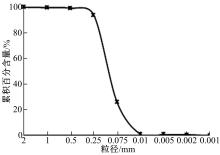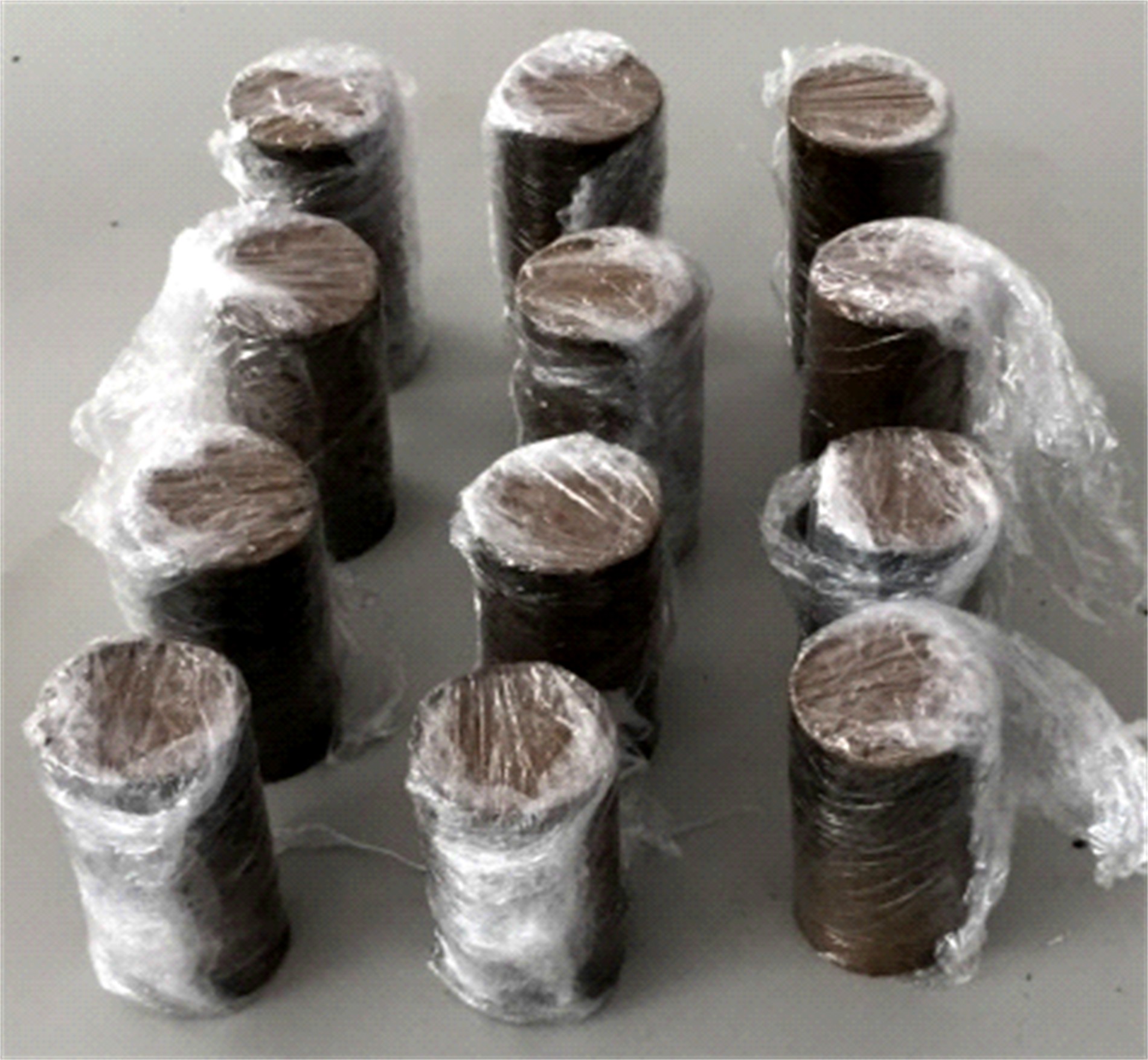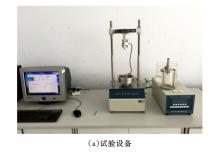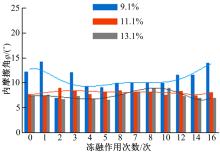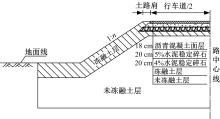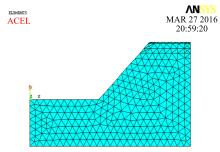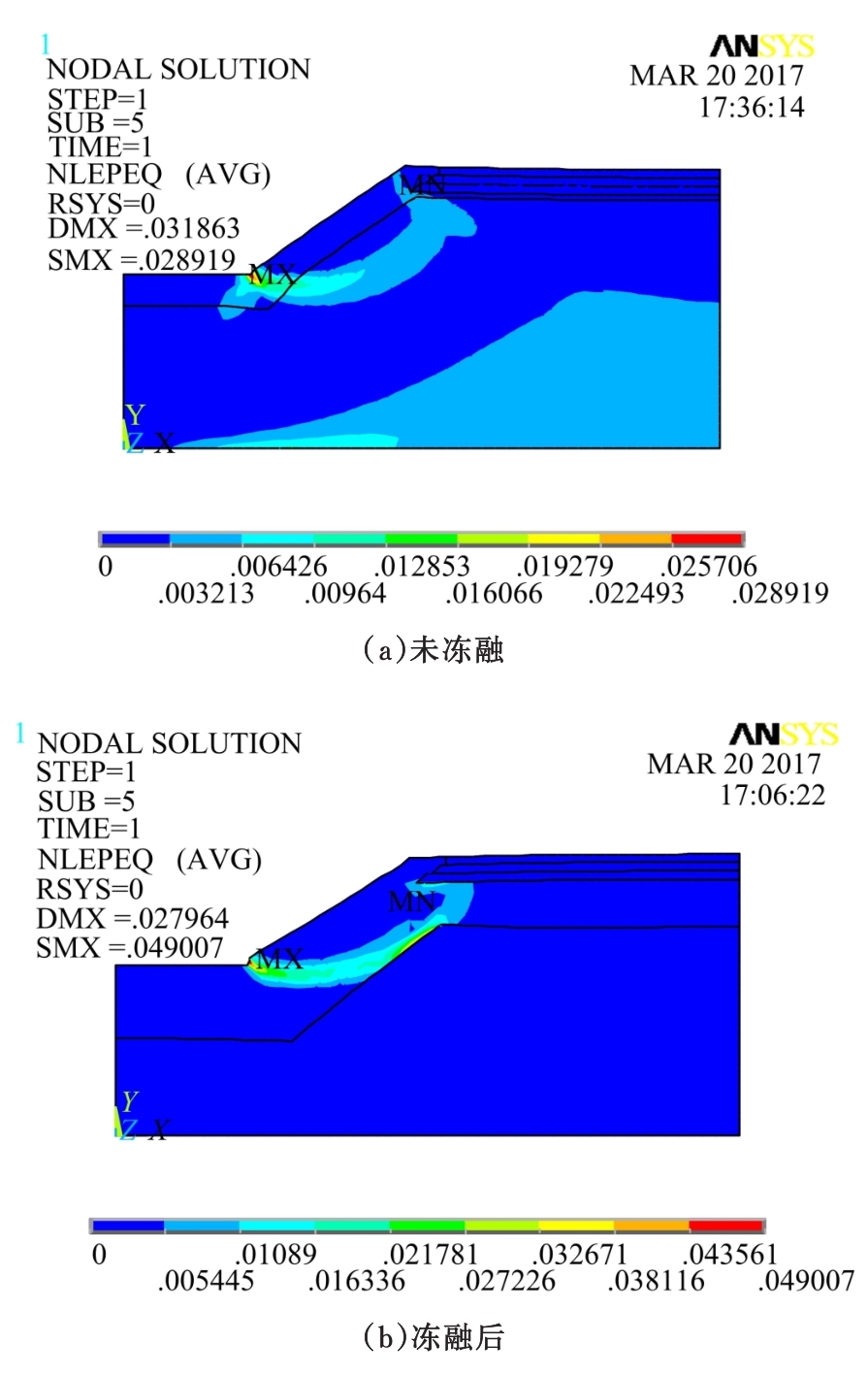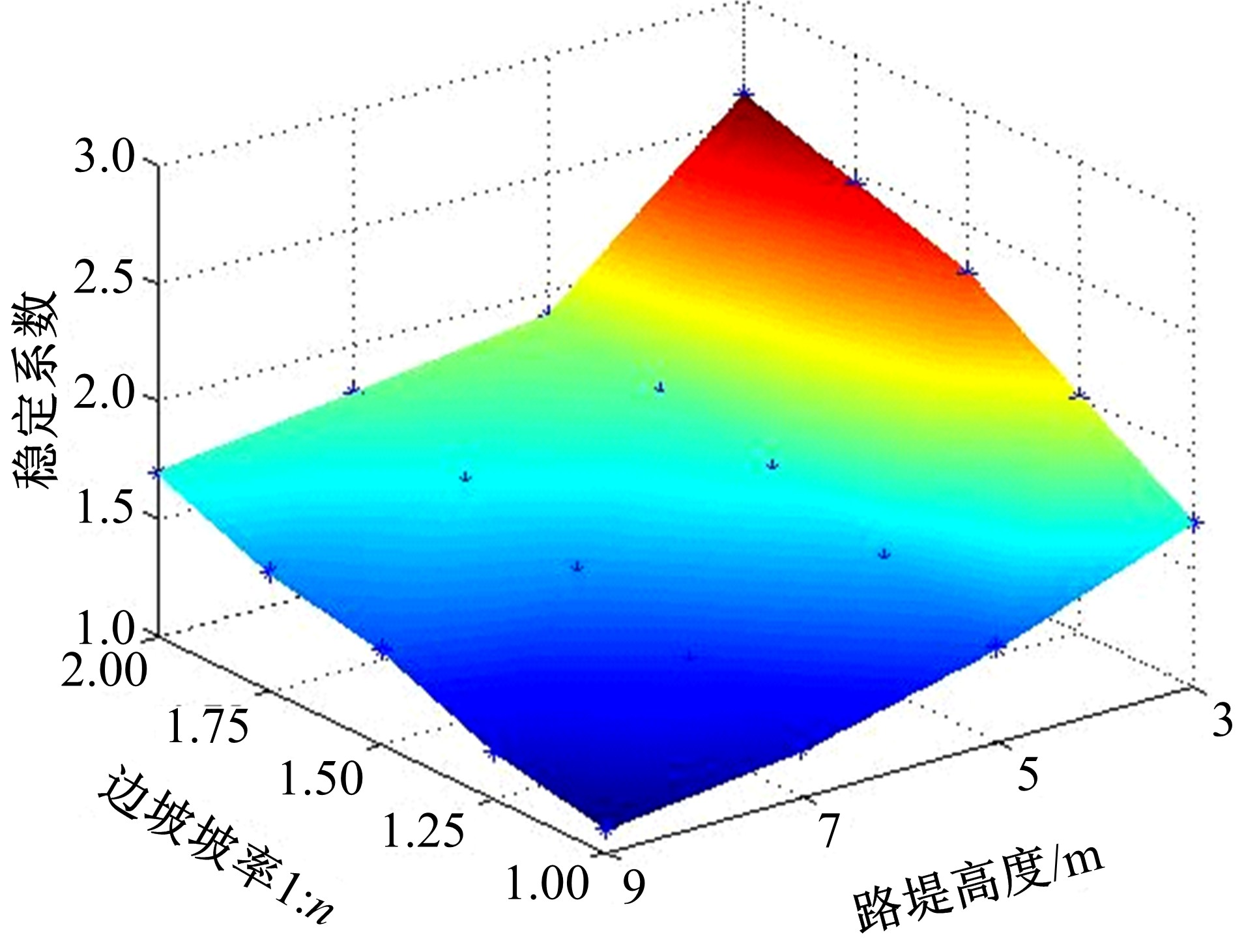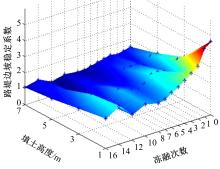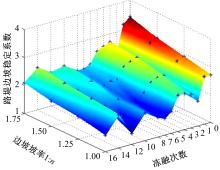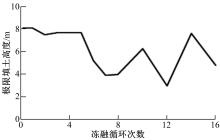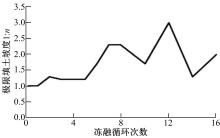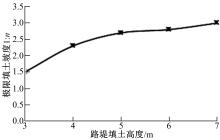Journal of Jilin University(Engineering and Technology Edition) ›› 2019, Vol. 49 ›› Issue (5): 1531-1538.doi: 10.13229/j.cnki.jdxbgxb20180257
Effects of freeze-thaw cycles on mechanical properties of silty sand and subgrade slope stability
Yun-long ZHANG1( ),Liu-guang ZHOU1,2,Jing WANG1,Chun-li WU3(
),Liu-guang ZHOU1,2,Jing WANG1,Chun-li WU3( ),Xiang LYU3
),Xiang LYU3
- 1. School of Transportation Science, Jilin Jianzhu University, Changchun 130118, China
2. Jiangsu Dong Dao Transportation Science & Technology Group,Nanjing 210011,China 3. College of Transportation, Jilin University, Changchun 130022, China
CLC Number:
- U416.1
| 1 | BondarenkoG I, SadovskyA V. Water content effect of the thawing clay soils on shear strength[C]∥Proceedings of 7th International Symposium on Ground Freezing, Rotterdam, Netherlands, 1991: 123-127. |
| 2 | OgataN, KataokaT, KomiyaA. Effect of freezing-thawing on the mechanical properties of soil[C]∥Proceedings of the 4th International Symposium on Ground Freezing, Sapporo, 1985: 5-7. |
| 3 | 谈云志, 吴翩, 付伟, 等. 改良粉土强度的冻融循环效应与微观机制[J]. 岩土力学, 2013, 34(10): 2827-2834. |
| TanYun-zhi, WuPian, FuWei, et al. Strength and micromechanism of improved silt under freeze-thaw cycle effect[J]. Rock and Soil Mechanics, 2013, 34(10): 2827-2834. | |
| 4 | 朱志铎, 刘松玉, 邵光辉, 等. 粉土及其稳定土的三轴试验研究[J]. 岩土力学, 2005, 26(12): 1967-1971. |
| ZhuZhi-duo, LiuSong-yu, ShaoGuang-hui, et al. Research on silts and silts treated with stabilizers by triaxial shear tests[J]. Rock and Soil Mechanics, 2005, 26(12): 1967-1971. | |
| 5 | 严晗, 王天亮, 刘建坤, 等. 反复冻融条件下粉砂土动力学参数试验研究[J]. 岩土力学, 2014, 35(3): 683-688. |
| YanHan, WangTian-liang, LiuJian-kun, et al. Experimental study of dynamic parameters of silty soil subjected to repeated freeze-thaw[J]. Rock and Soil Mechanics, 2014, 35(3):683-688. | |
| 6 | 严晗, 王天亮, 刘建坤. 粉砂土反复冻胀融沉特性试验研究[J]. 岩土力学, 2013, 34(11): 3159-3165. |
| YanHan, WangTian-liang, LiuJian-kun. Experimental study of repeated frost heave and thaw settlement properties of silty sand[J]. Rock and Soil Mechanics, 2013, 34(11): 3159-3165. | |
| 7 | 蔡迎春, 郑元勋, 刘忠玉, 等. 飞机荷载作用下粉砂土路基动力响应研究[J]. 岩土力学, 2012, 33(9): 2863-2868. |
| CaiYing-chun, ZhengYuan-xun, LiuZhong-yu, et al. Study of dynamic response of silty sand subgrade loaded by airplane[J]. Rock and Soil Mechanics, 2012, 33(9): 2863-2868. | |
| 8 | 常丹, 刘建坤, 李旭. 冻融循环下粉砂土应力-应变归一化特性研究[J]. 岩土力学, 2015, 36(12): 3500-3505. |
| ChangDan, LiuJian-kun, LiXu. Normalized stress-strain behavior of silty sand under freeze-thaw cycles[J]. Rock and Soil Mechanics, 2015, 36(12): 3500-3505. | |
| 9 | 严晗, 刘建坤, 王天亮. 冻融对粉砂土力学性能影响的试验研究[J]. 北京交通大学学报, 2013, 37(4): 73-77. |
| YanHan, LiuJian-kun, WangTian-liang. Experimental research of influences of freeze-thaw on the mechanical properties of silty soil[J]. Journal of Beijing Jiao Tong University, 2013, 37(4): 73-77. | |
| 10 | 常丹, 刘建坤, 李旭. 冻融循环下粉砂土屈服及强度特性的试验研究[J]. 岩石力学与工程学报, 2015, 34(8): 1721-1728. |
| ChangDan, LiuJian-kun, LiXu. Experimental study on yielding and strength properties of silty sand under freezing-thawing cycles[J]. Chinese Journal of Rock Mechanics and Engineering, 2015, 34(8): 1721-1728. | |
| 11 | 陈鹏, 徐博侯. 基于因素敏感性的边坡稳定可靠度分析[J]. 中国公路学报, 2012, 25(4): 42-48. |
| ChenPeng, XuBo-hou. Reliability analysis of slope stability based on factors sensitivity[J]. China Journal of Highway and Transport, 2012, 25(4): 42-48. | |
| 12 | 李航, 于玲. 冻融循环作用下路基边坡稳定性变化研究[J]. 路基工程, 2011(5): 26-28, 32. |
| LiHang,YuLing. Study on subgrade slope stability under the effect of freeze-thaw cycle[J]. Subgrade Engineering, 2011(5): 26-28, 32. | |
| 13 | 陈国庆, 黄润秋, 石豫川, 等. 基于动态和整体强度折减法的边坡稳定性分析[J]. 岩石力学与工程学报, 2014, 33(2): 243-256. |
| ChenGuo-qing,HuangRun-qiu,ShiYu-chuan,et al. Stability analysis of slope based on dynamic and whole strength reduction methods[J]. Chinese Journal of Rock Mechanics and Engineering, 2014, 33(2): 243-256. | |
| 14 | 栾茂田, 武亚军, 年廷凯. 强度折减有限元法中边坡失稳的塑性区判据及其应用[J]. 防灾减灾工程学报, 2003, 23(3): 1-8. |
| LuanMao-tian, WuYa-jun, Ting-kaiNian . An alternative criterion for evaluating slope stability based on development of plastic zone by shear strength reduction FEM[J]. Journal of Disaster Prevention and Mitigation Engineering, 2003, 23(3): 1-8. | |
| 15 | 陈祖煜. 土质边坡稳定分析[M]. 北京: 中国水利水电出版社, 2003. |
| [1] | Yong PENG,Hua GAO,Lei WAN,Gui-ying LIU. Numerical simulation of influence factors of splitting strength of asphalt mixtures [J]. Journal of Jilin University(Engineering and Technology Edition), 2019, 49(5): 1521-1530. |
| [2] | Tian⁃lai YU,Hai⁃sheng LI,Wei HUANG,Si⁃jia WANG. Shear strengthening of reinforced concrete beam with prestressed steel wire ropes [J]. Journal of Jilin University(Engineering and Technology Edition), 2019, 49(4): 1134-1143. |
| [3] | Xiao⁃zhen LI,Jun⁃zhe LIU,Yan⁃hua DAI,Zhi⁃min HE,Ming⁃fang BA,Yu⁃shun LI. Effect of carbonation on nitrite ion distribution in cement paste [J]. Journal of Jilin University(Engineering and Technology Edition), 2019, 49(4): 1162-1168. |
| [4] | Xiao⁃ming HUANG,Qing⁃qing CAO,Xiu⁃yu LIU,Jia⁃ying CHEN,Xing⁃lin ZHOU. Simulation of vehicle braking performance on rainy daysbased on pavement surface fractal friction theory [J]. Journal of Jilin University(Engineering and Technology Edition), 2019, 49(3): 757-765. |
| [5] | Jing WANG,Xiang LYU,Xiao⁃long QU,Chun⁃ling ZHONG,Yun⁃long ZHANG. Analysis of relationship between subgrade soil shear strength and chemical and minerals component [J]. Journal of Jilin University(Engineering and Technology Edition), 2019, 49(3): 766-772. |
| [6] | LI Yi,LIU Li-ping,SUN Li-jun. Prediction model on rutting equivalent temperature for asphalt pavement at different depth [J]. Journal of Jilin University(Engineering and Technology Edition), 2018, 48(6): 1703-1711. |
| [7] | ZANG Guo-shuai, SUN Li-jun. Method based on inertial point for setting depth to rigid layer [J]. 吉林大学学报(工学版), 2018, 48(4): 1037-1044. |
| [8] | NIAN Teng-fei, LI Ping, LIN Mei. Micro-morphology and gray entropy analysis of asphalt characteristics functional groups and rheological parameters under freeze-thaw cycles [J]. 吉林大学学报(工学版), 2018, 48(4): 1045-1054. |
| [9] | GONG Ya-feng, SHEN Yang-fan, TAN Guo-jin, HAN Chun-peng, HE Yu-long. Unconfined compressive strength of fiber soil with different porosity [J]. 吉林大学学报(工学版), 2018, 48(3): 712-719. |
| [10] | CHENG Yong-chun, BI Hai-peng, MA Gui-rong, GONG Ya-feng, TIAN Zhen-hong, LYU Ze-hua, XU Zhi-shu. Pavement performance of nano materials-basalt fiber compound modified asphalt binder [J]. 吉林大学学报(工学版), 2018, 48(2): 460-465. |
| [11] | JI Wen-yu, LI Wang-wang, GUO Min-long, WANG Jue. Experimentation and calculation methods of prestressed RPC-NC composite beam deflection [J]. 吉林大学学报(工学版), 2018, 48(1): 129-136. |
| [12] | ZHANG Yang-peng, WEI Hai-bin, JIA Jiang-kun, CHEN Zhao. Numerical evaluation on application of roadbed with composite cold resistance layer inseasonal frozen area [J]. 吉林大学学报(工学版), 2018, 48(1): 121-126. |
| [13] | MA Ye, NI Ying-sheng, XU Dong, DIAO Bo. External prestressed strengthening based on analysis of spatial grid model [J]. 吉林大学学报(工学版), 2018, 48(1): 137-147. |
| [14] | LUO Rong, ZENG Zhe, ZHANG De-run, FENG Guang-le, DONG Hua-jun. Moisture stability evaluation of asphalt mixture based on film pressure model of Wilhelmy plate method [J]. 吉林大学学报(工学版), 2017, 47(6): 1753-1759. |
| [15] | NI Ying-sheng, MA Ye, XU Dong, LI Jin-kai. Space mesh analysis method for shear lag effect of cable-stayed bridge with corrugated steel webs [J]. 吉林大学学报(工学版), 2017, 47(5): 1453-1464. |
|
||
